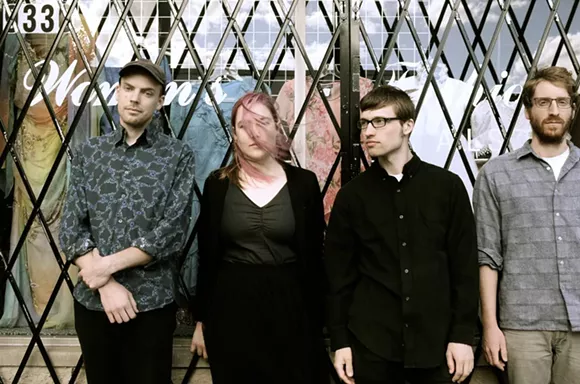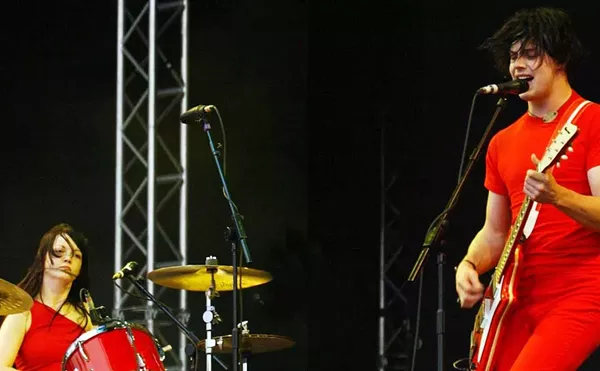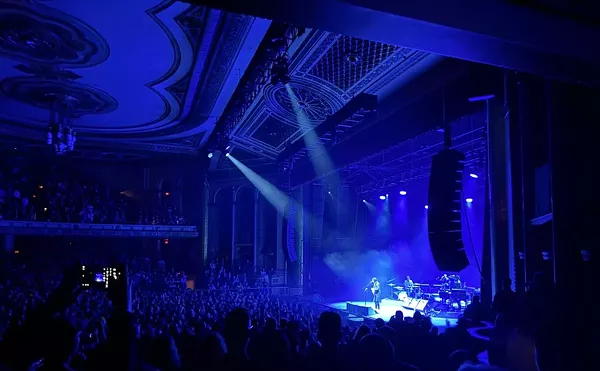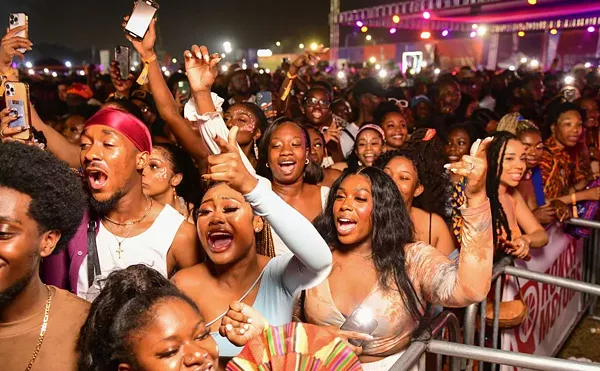
Audio By Carbonatix
[
{
"name": "GPT - Leaderboard - Inline - Content",
"component": "35519556",
"insertPoint": "5th",
"startingPoint": "3",
"requiredCountToDisplay": "3",
"maxInsertions": 100,
"adList": [
{
"adPreset": "LeaderboardInline"
}
]
}
]

Sometimes a band can be summed up in a word. Saajtak is not one of these bands, although if you had to pick just one word, experimental would probably be a good one. But even then it's hard to leave it at that; the experimentation happens at so many levels.
Formed in 2014, the Detroit-based four-piece features vocalist Alex Koi, electronic artist Simon Alexander-Adams, drummer Jon Taylor, and bassist Ben Willis. The members gravitated to each other during time spent in the University of Michigan's Creative Arts Orchestra, a fitting breeding ground for sympathetic explorers to meet as they hone their composition and improvisation skills.
Spokes is their first physical output, self-released just this March, and the four tracks are a telling combination of the group's exploratory efforts. Polyrhythmic grooves, effervescent textures, operatic vocals — these are just some of the building blocks of Saajtak. When combined, the atmosphere is nothing short of explosively haunting — a miasma of emotive force and unpredictable compositions.
The effort to categorize Spokes shifts within songs, let alone between them; a terrifying prog jazz opera comes toe to toe with elements of Indian classical, harsh noise, and dance music. But the members of Saajtak have the chops needed to make it all work, a true blend of their many disparate influences, which include everyone from Chick Corea to Kate Bush to Lightning Bolt to Alla Rakha — and that's just scratching the surface.
It comes as little surprise that individually, the members — who are all in their 20s — have performed with acts as wide-ranging in style as the art pop of My Brightest Diamond, the legendary bass of original Griot Galaxy member Jaribu Shahid (the experience of which drummer Taylor describes as "very special," citing Shahid's ability to make one "dig deeper, every note and every second") and the post-industrial noise of Wolf Eyes; or that the group's latest gig opening for a national act has been for none other than experimental noise pop freaks Xiu Xiu.
2017 has been one of Saajtak's busiest years yet; the release of Spokes was accompanied by a live video for the title track, an East Coast tour, and many more performances to come, including two this weekend. We had to know more about the group's enigmatic sound, so we picked their brains to find out what they individually bring to the sonic table and their personal goals when it comes to what they create.
Metro Times: The group's artistic practice is described as incorporating Jonathan and Alex's love of jazz, Ben's experience in the western art music tradition, and Simon's work in multimedia and performance art technology — can each person speak to what they bring?
Ben Willis: This group communicates very much like a small chamber ensemble, like a string quartet. Often we rely on each other for subtle cues through the music, and our parts interlock and sometimes pass around the ensemble. As we compose our music together, having a background performing chamber music helps to inform ideas for instrument roles and the sense of pacing and song form. Playing contemporary works for open instrumentation, like those of Pauline Oliveros and Frederic Rzewski, has certainly informed how I view my role in an ensemble, and what the possibilities between four people can be.
Simon Alexander-Adams: My experience as a pianist and improviser are important components, but my playing and sound design is definitely informed by my experience as a sonic explorer — producing electronic music, building new interfaces for musical expression, creating interactive audio installations, and even doing sound design for theater, dance, animation, and film. It all comes together in the sounds I create for Saajtak, which involve everything from granular synthesis to turning random files on my computer into audio files.
Jon Taylor: While we come from different backgrounds with regards to our training, we all share an enthusiasm for sound. I know that we each have a very wide listening palette and love to share whatever it is we're checking out. Playing together is kind of the same; we individually contribute our current state of mind and taste, and if successful, blend it into a cohesive musical statement.
Alex Koi: We focused on those practices in study before, but our spheres of influence extend much further. Still, though, that's an interesting question because there are defining things brought to the table by each of us. Now that I think about it, I mostly conceptualize those differences with respect to personality, mode of intellect, and how we process ideas — not genre. Musically and interpersonally, we balance each other well. That's why the music feels so good.
MT: What are you trying to achieve with the way you manipulate sounds?
Alexander-Adams: For my setup, I have the challenge of designing my sounds for each composition as we develop it. I work to find a couple really interesting parameters that I can manipulate live, which is usually the most I like to have on a given sound. I have knobs and sliders, as well as foot pedals that I can map to these parameters so I can perform our whole set without touching the computer — a format that I really appreciate while playing live.
Willis: While use of electronics opens up many worlds of timbral possibilities, it also comes with the risk of being unnecessarily dense or desultory. In all of our songs, we try to hone sounds that are complementary to each other. This is sometimes informed by instrument role — I may pitch-shift my bass up to a high "guitar-like" texture while Simon is holding down the lower information — but is often about finding timbres that jell with each other or contrast in effective ways.
MT: Alex, you've said, "I'm an instrument, a texture, or a bass line" with regard to your role, as opposed to the traditional idea of a "singer." Tell me about this.
Koi: I was a kid that played in the dirt and created ornate murals on my bedroom walls. There was never any conversation or lesson on the correct way of doing those things. Singing was the same way. I explored and discovered. There were many years of learning purely from experimentation and by imitating records, both vocal and instrumental, first. All my music is based in a foundational center of feeling and play, so I like my singing to be limitless. Why confine an instrument to stereotypes and conventions? Traditional vocal words like "pretty," "lyrical," [and] "floating" aren't everything. I like grit, tragedy, and terror too because those experiences elicit reflection and explosive response.
MT: What do you consider your personal goals within the music you make?
Willis: I hope to make experiential music that allows people to shift their focus, to provide another space to view life from.
Taylor: One of my favorite improvisers, Frank Rosaly, said something along the lines of "powerful music makes one feel present, and to be present is to be alive." Everyone knows that unnamable mental and spiritual space that comes from absorbing work, or from experiencing impactful art. My goal every day is to expand my relationship with that space, in practice, in listening, and in performance. Hopefully the listeners feel inspired and transported themselves.
Koi: I make music for myself, and by extension, hope that others feel deeply from it. A more intellectual pursuit is to inspire listeners to readjust their perspective on vocalists and women musicians in general. In the Western musical tradition, there's all sorts of gendered stigmas hanging around the vocalist. A common one being that vocalists aren't musicians. These stigmas are complicated and misogynistic. It's meant as a compliment that fans tell me I'm a "true musician," but often it's said in a way that discredits me as a vocalist. I've had (male) listeners insist that I'm "more than a vocalist," sometimes trying to argue the point with me, which is just silly because I just poured my guts out onstage and also because what the hell is wrong with being a vocalist?! Our voices are the most amazing gift we have.
MT: Can you tell me about your subject matter in the lyrics?
Koi: In the three years that we worked on these compositions, we witnessed serious musical transformations and expansions in all four. Ninety percent of the time, I'm putting lyrics to a melody I've already got swimming in my head. With Spokes, I encountered the challenging task of creating cohesive narrative arcs over a bumpy course of key changes and meter changes. Strong lyric writing is aware of the minutiae of these changes and appropriately predicts, reacts, or syncs with them all while creating a statement. Songs like "The Keeper," an immersive retrospective on aging and living, and "Asimo's Epilogue," a thematic-based reflection on human nature, transhumanism, and illusion, are more traditional narratives complete with metaphor and character development. "Spokes" and "Underscore" are abstracted, more part-phrases and guttural sounds, so to imitate gestures of a mind's unraveling amidst over-saturations of input and emotion. I'd say that while "Underscore" ends in helplessness, "Spokes" ends in apathy. All that being said, it's important that the EP's many joyous expressions are noted, as well. [With] "Asimo," for instance, I think, how marvelous it is that we've created this affectionate homage to our little robot heroine.
Saajtak plays UFO Factory with Sterling Toles, Tarpit, and Party Days on Friday, July 7; Starts at 9 p.m.; 2110 Trumbull St, Detroit; ufofactory.com; $8.
Saajtak plays Trinosophes with Jonah Parzen-Johnson on Saturday, July 8; Starts at 8 p.m.; 1464 Gratiot Ave, Detroit; trinosophes.com; $8.
Get Spokes on CD at a live performance or online through Saajtak.bandcamp.com.





